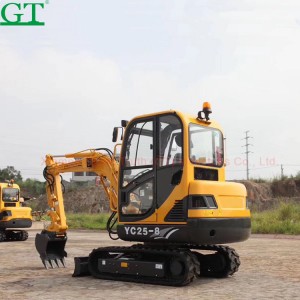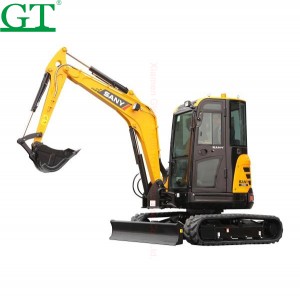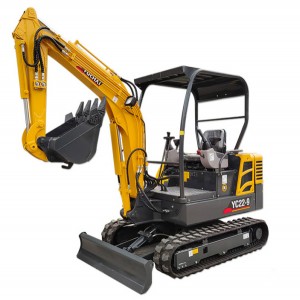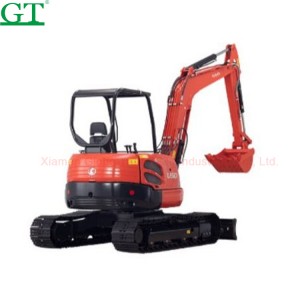7 Types of Excavators
The types of excavators each have their features and uses:
Crawler Excavators: Also known as standard excavators, these are typically used for the bulk of excavation jobs. They are equipped with tracks instead of wheels, which provides them with excellent stability and balance on various terrains. Thanks to the tracks, they are well-suited for working on uneven or soft ground, such as mud or sandy soils. They are commonly used for digging, trenching, earthmoving, and heavy lifting.
Wheeled Excavators: Compared to crawler excavators, wheeled excavators have better mobility and are suitable for hard surfaces and urban environments. They can move quickly on roads, making them ideal for situations where the work site frequently changes.
Dragline Excavators: This type of excavator is typically used for large-scale excavation operations, such as surface mining and deep pit excavation. Dragline excavators have a large bucket that is suspended by cables and used for "dragging" material. They are particularly suited for long-distance digging and moving large volumes of material.
Suction Excavators: Also known as vacuum excavators, these use high-pressure suction to remove debris and soil from the ground. They are often used for clearing the ground when laying underground utilities to avoid damaging existing infrastructure.
Skid Steer Excavators: These small excavators are extremely versatile and can operate in tight spaces. Their design allows for rapid attachment changes, such as buckets, hammers, brooms, etc., suitable for a variety of tasks like demolition, soil mixing, and cleanup.
Long Reach Excavators: With an extended arm and bucket, they are suitable for areas that standard excavation equipment can't reach. They are commonly used for demolishing buildings, clearing waterways, and other situations that require long-distance operation.
Mini Excavators: Mini excavators are small in size and very suitable for working in confined spaces, such as urban environments or narrow sites. Despite their smaller size compared to larger excavators, they remain powerful and effective and are often used for small-scale excavation projects and landscaping work.
These types of excavators are designed according to specific work requirements and play a vital role from small garden projects to large construction projects.
1. Crawler Excavators

Unlike other large excavators that run on wheels, crawlers run on two large endless tracks and are optimal for mining and heavy-duty construction jobs. Also known as compact excavators, these excavators use hydraulic power mechanisms to lift heavy debris and soil.
Their chain wheel system allows them to slide down and scale hills with less risk, making them suitable for grading hilly areas and landscaping uneven terrain. While slower than other excavators, crawlers provide greater balance, flexibility and stability overall.
Pros: Provide greater balance and stability on uneven ground
Cons: Slower than some other excavators
2. Wheeled Excavators

Wheeled excavators are similar in size and appearance to crawlers but run on wheels instead of tracks. Replacing tracks with wheels makes them faster and easier to maneuver on concrete, asphalt and other flat surfaces while still offering the same power capabilities.
Because wheels offer less stability on uneven ground than tracks, wheeled excavators are commonly used for roadwork and urban projects. However, operators can add outriggers to increase stability when transitioning between asphalt or concrete and an uneven surface.
Pros: Fast and easy to maneuver on flat surfaces
Cons: Perform poorly on uneven terrain
3. Dragline Excavators

The dragline excavator is a larger excavator that operates with a different process. The equipment utilizes a hoist rope system that attaches to a bucket via a hoist coupler. The other side of the bucket is affixed to a dragline that runs from the bucket to the cab. The hoist rope raises and lowers the bucket while the dragline pulls the bucket toward the driver.
Due to their weight, draglines are often assembled on-site. The unique system of this type of excavator is commonly used in large-scale civil engineering projects like canal dreading.
Pros: Dragline system is ideal for underwater excavating and canal dreading
Cons: Weight and size make it impractical for smaller jobs
4. Suction Excavators

Also known as vacuum excavators, suction excavators feature a suction pipe capable of providing up to 400 horsepower. The excavator first releases a water jet to loosen the ground.
The pipe, which contains sharp teeth at the edge, then creates a vacuum that carries away soil and debris up to 200 miles per hour.
A suction excavator is ideal for delicate underground applications, as it can reduce the chance of damage by more than 50 percent.
Pros: Added precision reduces damage during delicate jobs
Cons: Narrow suction pipes are impractical for large-scale applications
5. Skid Steer Excavators

Unlike standard excavators, skid steers have booms and buckets that face away from the driver. This orientation allows the attachments to reach over the cab instead of around it, making these excavators useful in more narrow areas and maneuvering tricky turns.
They are often used for digging pools, site cleaning, residential work and debris removal, where space is more limited and objects are spread far apart.
Pros: Easy to maneuver in tight and narrow spaces
Cons: Don’t perform as well on uneven or slippery surfaces
6. Long Reach Excavators

As its name suggests, a long reach excavator features a lengthier arm and boom sections. The design allows for better operation in hard-to-reach locations. The excavator’s extendable arm can reach over 100 feet horizontally.
These excavators are best used for demolition projects like structural crumbling and breaking down walls over bodies of water. Different attachments can be affixed to the arm to perform additional jobs such as shearing, crushing and cutting.
Pros: Longer boom is ideal for hard-to-reach locations and demolition projects
Cons: Difficult to use in tight spaces
7. Mini Excavators

In recent years, more contractors are using mini excavators, a smaller and lighter version of the standard excavator capable of minimizing ground damage and fitting through crowded, narrow sites like parking lots and indoor spaces. Also known as compact excavators, mini excavators typically incorporate reduced tail-swing or zero tail-swing to maneuver tighter turns and avoid contact with any obstacles.













